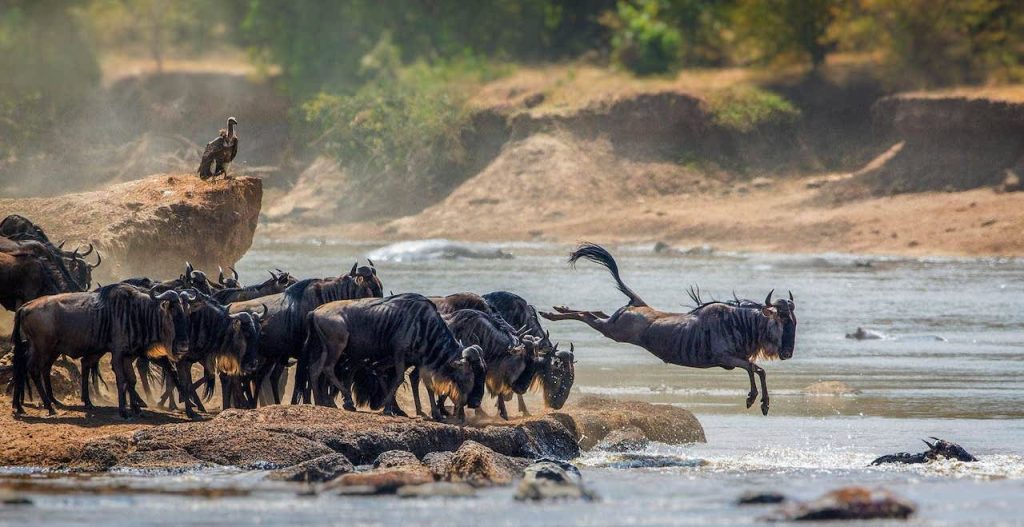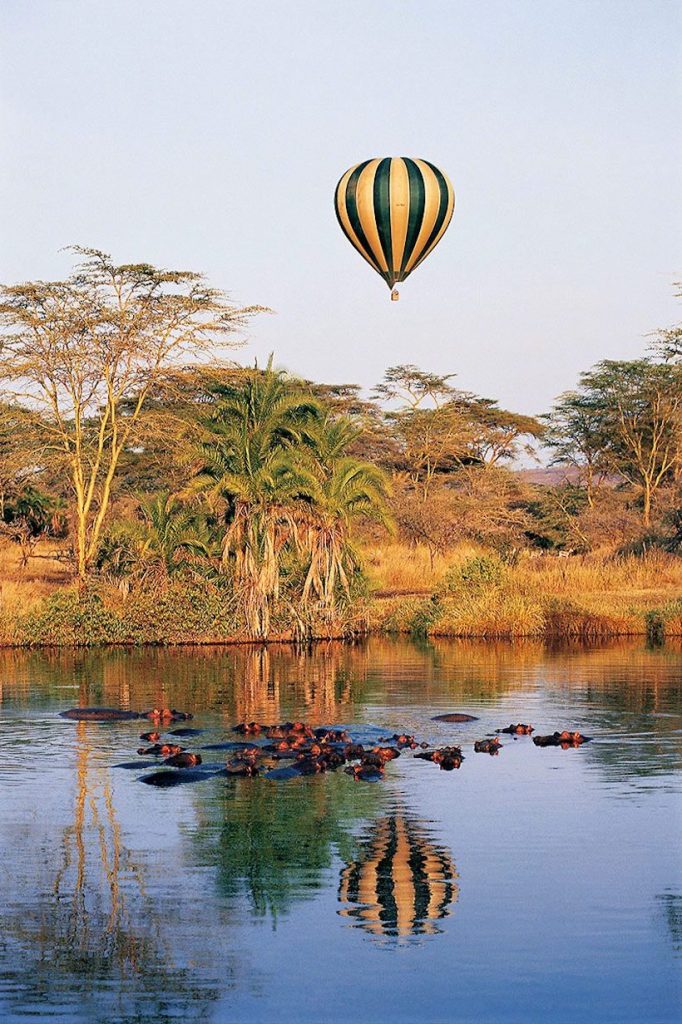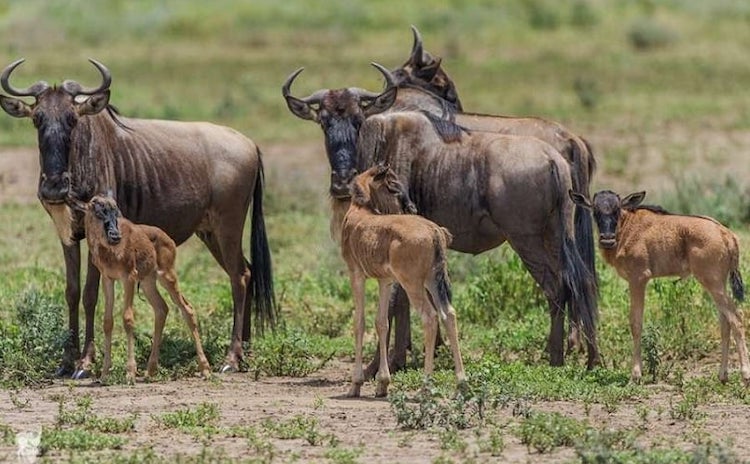Serengeti National Park, located in the northeast of Tanzania is one of the world’s most popular wildlife tourism destinations. This wonderful natural habitat was first established as a game reserve in 1921 by the Tanzanian government, afterward in 1948, it was combined with Ngorongoro to make a park. In order to relocate the Maasai pastoralists from Serengeti Park, it was disbanded from Ngorongoro to be managed solely later in 1951.
Serengeti National Park is 5,700 square miles in size and about 3,7000,000 acres of it are virgin savanna making it one of the largest animal habitats in Africa. This Tanzanian-based game park is situated totally in the eastern Mara Region and northeast portion of the Simiyu Region, neighboured by the Ngorongoro Conservation Area in the north, Loliondo Game Control Area in the east, Ikorongo and Grumeti Game reserves in the west.
The Park is split into 3 parts. The famous southern/central part (Seronera Valley), known to be the liveliest part of the park endowed with lots of animals. The Maasai call it “Siringit” meaning endless plains. The western corridor is dominated by the Grumeti River, thick forests, and bushes. And The Lobo area in the north connecting with Kenya’s Masai Mara Reserve and is the least explored part.
 The great Serengeti’s vegetation cover is breathtakingly characterized by unceasing open savannah plains, woodlands, and riverine forests. Due to its openness, the area largely receives heat and hot winds throughout the year.
The great Serengeti’s vegetation cover is breathtakingly characterized by unceasing open savannah plains, woodlands, and riverine forests. Due to its openness, the area largely receives heat and hot winds throughout the year.
Serengeti has the highest concentration of large mammals in Africa and this is mainly attributed to its vast short savannah grasslands which are a conducive environment for living organisms. The park holds the largest population of lions on the continent, leopards are said to be 5.4 individuals per square kilometre, and also a colossal number of giraffes, rhinos, elephants, elands, crocodiles, hyenas, mongooses, cape buffaloes are registered in the locality. With a staggering concentration of elephants, lions, leopards, lions, giraffes, zebras, and buffaloes that live in its easily fathomed immaculate short savannah, Serengeti is considered the best plug for game viewing in Africa.
Noteworthy, the Serengeti region hosts the largest animal movement present popularly known as the great migration of wildebeests. Ungulates comprising millions of wildebeests and thousands of zebras and gazelles trek from the Serengeti plains to the northern region reaching Masai Mara in Kenya looking for pasture and water in the dry months of the year. This wonderful phenomenon presents amazing sights especially when the ungulates are crossing the Grumeti and Mara Rivers where they tussle it out with the crocodiles. Tourists of Serengeti love the spontaneous and eye-catching rendition availed by the ungulates. This natural occurrence is the most sought-after attraction in the park.
Things to do in Serengeti National Park
Due to the presence of an astronomical population of wildlife species and a couple of physical and historical features, Serengeti national park has a lot of activities to engage in and they are as below;
Safari Game Drive
Serengeti offers the best game drive experience in Africa because of its easily penetrated open savannah with a staggering number of exotic animals. The activity involves exploring the park by 4×4 vehicle with a pop-up roof searching and watching the various wild animals. Game drives are only allowed during the day in the main Serengeti, the night game drives are carried out in the reserves. To fully explore Serengeti and enjoy its animals, tourists are recommended to conduct a two-day game drive. The central part of the park, commonly known as Seronera where the activity is done is such a large expanse. However, for tourists with limited time on the safari, a four-hour game drive is arranged for them. To comprehensively explore the park and see most of the popular mammals, game rangers are suggested to be hired. These individuals are custodians of the park with vast information about the animals and knowledge of their breeding areas. The popular possible animals to encounter on a safari game drive in Serengeti national park include lions, rhinos, buffaloes, giraffes, elephants, leopards, zebras, elands, gazelles, birds and hippos, and crocodiles which roam in the rivers.
Typically the safari tours that include Serengeti National Park for several days include a visit to the other parks in Northern Tanzania including; Ngorongoro, Lake Manyara and Tarangire National Park.
Walking Safaris
It seems surreal to trek in the wilderness of Serengeti filled with lots of predators but it is practicable and extremely exciting in the virgin and forested areas in the western corridor. Tourists are able to experience and encounter different tree species, reptiles, amphibians, beautiful birds, scintillating water streams, sublime stones like Kopjes, and grazers (topis, zebras, gazelles, elands, giraffes, reedbucks, wildebeests, and so forth). For safety, nature walks are done under the stewardship of park rangers equipped with guns for protection if stray animals try to attack the trekkers.
Hot Air Balloon Safari
 The hot air balloon grants a chance of viewing the landscapes and wildlife of Serengeti in the skies. The best experience is availed during the great migration of wildebeests and zebras. It is really captivating and eye-catching to see such a high concentration of animals from an aerial view. The hot air balloon cabin can be occupied by a maximum of 16 people. Because of its uniqueness, it is more expensive than the ground game viewing expedition thus costing 500$ per person.
The hot air balloon grants a chance of viewing the landscapes and wildlife of Serengeti in the skies. The best experience is availed during the great migration of wildebeests and zebras. It is really captivating and eye-catching to see such a high concentration of animals from an aerial view. The hot air balloon cabin can be occupied by a maximum of 16 people. Because of its uniqueness, it is more expensive than the ground game viewing expedition thus costing 500$ per person.
Experiencing the Great Migration of the Wildebeest
The Serengeti plains offer one of the natural marvels in the world. The great migration of wildebeests is regarded as one of the greatest seven natural wonders in the world. At present, there is no larger movement of animals in the world compared to this spectacle. Over a million wildebeests accompanied by thousands of gazelles and zebra migrate from central Serengeti to as far as Maasai Mara in Kenya and back looking for pasture and water in the dry periods of the year. To stand a chance of witnessing this great spectacle, visit Serengeti national park in the months of June- September, and December through March. The incredible scenes are caught around Grumeti and Mara Rivers, the ungulates bump into crocodiles, erupting into a tussle and scrimmage bout.
Bush meals (lunch or bush dinner)
A meal in the open short savannahs of Serengeti is one way of rekindling your love with your partner. The environment is so nonchalant, the noise only comes with chirping birds and loitering animals. The dining set is organized in a cozy and sumptuous way, making guests have a sensational experience as they savor their favorite delicacies. The best meals to have in the jungle is breakfast in the morning and dinner in the evening when the sun is at its full beauty radiating gold. Do not forget to carry a camera with you because these moments render stunning pictures.
Bird watching
Serengeti is a significant birding spot in Tanzania with over 500 species registered in the area. 100 species are permanent residents of the area, 11 are endemic to the great Serengeti ecosystem and others are migratory. The popular birds to possibly watch in the environs of Serengeti include sparrows, vultures, pelicans, lesser flamingos, and shoebills among others.
Camping in the Serengeti
While camping in Serengeti, you can either go for luxury raised permanent tent camping or budget ground tent camping. Nonetheless, both kinds of camping avail the same experience and elation because you spend a night in the middle of the jungle. The difference is in the setup of the tent structures. Camp in the jungles of Serengeti to enjoy roasting yourself around the fire as you have drinks, listen and tell stories, and play social bonding games. Ensure to hire a chef for cooking and a park guard for protection against wild animals.
The Bologonja Springs Tour
The Bologonja spring is one of the amazing natural features in Serengeti to see and appreciate the beauty of nature. Watch water rise from the ground to churn in the air like a fountain. Additionally, a geographical explanation is rendered of how the springs came up hence making the tour insightful. Around the area animals such as elephants, giraffes, reedbucks, birds, and monkeys can be spotted.
Visit the Lobo Valley:
In the dry spells, an enormous popular of zebras and wildebeests reside in this valley because of its richness of green pastures. The predators such as lions and hyenas pounce on this opportunity to camp in the area for easy prey. Most tourists are taken to the Lobo valley to enjoy the wildebeests and zebra in the dry season.
Visit the Moru Kopjes:
Do wish to have a clear shot of lions or leopards in still form, the Moru kopjes is the place to visit. These predators are seen resting at the summits of the kopjes after a long hunt. The best time to find the predators at the top of the small rocks is in the afternoon. Rhinos are also present within the Moru kopjes area.
A tour at the Retina Hippos pool: An excursion to Retina permits tourists to witness one of the highest concentrations of hippos. Schools of hippos are seen submerged and their mouths wide open in the pond. Elephants and buffaloes come to this water pond to quench their thirst.
How to access Serengeti national park
Serengeti national park is situated approximately 364 kilometers northeast of Arusha and over 1,000 kilometers away from Dar-es-Salaam, the two starting points of most safaris in Tanzania. The ideal point to begin a safari is Kilimanjaro International Airport (Arusha) for international tourists because of its proximity to Serengeti. It is only 6 hours to reach the park from the Airport by road transport. To have easy access to Serengeti, use a local tour operator to organize a car hire and driver. For those of an affluent background and who have very limited time on their safari, scheduled flights are available from Kilimanjaro International Airport to airstrips in the Serengeti.
To shorten the driving time and distance from Arusha to Serengeti, most multi-day safari packages in Northern Tanzania includes a night stop at Tarangire or Lake Manyara National Park.
Serengeti various airstrips that serve the park and the surrounding game controlled areas and private reserves. These include; Seronerar Airtsrip (the main Airstrip), Lobo Airstrip, Kogatende Airstrip, Fort Ikoma, Grumeti, and Ndutu which is on the Ngorongoro side.
From the airstrips in the Serengeti, one can combine Northern and Southern Tanzania. You can easily combine Serengeti and the more remote parks like Ruaha National Park.
Best Time to Visit Serengeti

To set the record straight, Serengeti can be visited throughout the year. However, there are opinions on the best time to visit the park. Based on the majority of the past visitors to Serengeti, the best time to visit it is the dry season (June through October). This time avails a perfect game viewing experience and the migration of wildebeests being the main acme. The period of the migration of the ungulates changes every year (the prime time is June and July) whereas their reproduction happens from late January through February.
Thus, June to September is the best time for general game viewing with an opportunity of watching the wildebeest crossing the Grumeti River between June and July and the Mara River in September. This period is the peak season, the central Serengeti is crowded with tourists enjoying the wildlife. These are the times when there is little rainfall in the area. The skies are clear, the grasslands are open and the roads are passable.
In late January to February after the heavy rains of November, the wildebeests and other ungulates are calving, posing a chance to see the predators on the prowl.
In the wet season, the months of April, May, and November are regarded as the low season. The park gets a small number of tourists. This season comes with the merits of having a secluded trip since tourists are fewer. The rates of accommodation and transport are low in this season. The drawback is the heavy rains which make the roads impassable and also animals are in hiding.
Where to stay in the Serengeti National Park?
Serengeti being a prime tourist destination in Tanzania, is not short of establishments to lodge. The facilities vary from upmarket, middle class, to budget. These offer services like night stay, and meals and can also arrange tour activities and both air and ground transport. Some of the guests’ favorite lodges in Serengeti include Seronera Wildlife Lodge, Four Seasons Safari Lodge, Serengeti Serena Safari Lodge, Sayari Camp, Lamai Camp, Mwiba Lodge, and so forth.
